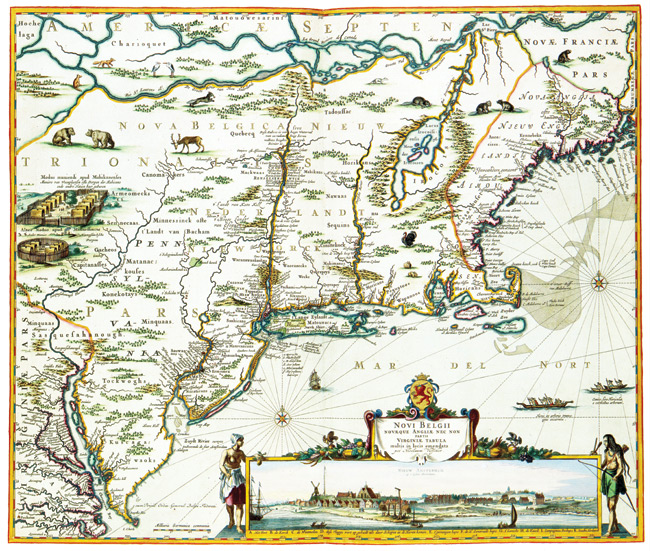|
Moderated by NW Okie! |
Volume 17 , Issue 452015Weekly eZine: (374 subscribers)Subscribe | Unsubscribe Using Desktop... |
Nieuw Nederlandt (New Netherland or New York)

The image on the left is the New Netherland with a view of New Amsterdam drawn by 17th century mapmaker Nicolaas Visscher.
Although the Netherlands only controlled the Hudson River Valley from 1609 until 1664, in that short time, Dutch entrepreneurs established New Netherland, a series of trading posts, towns, and forts up and down the Hudson River that laid the groundwork for towns that still exist today.
The Dutch were busy establishing their own colony about the same time Jamestown was getting underway, and a full decade before the Pilgrims happened upon Plymouth. Yet history books don’t give the Dutch settlers anywhere near the attention they do the latter-mentioned colonies.
Henry Hudson, a sailor, doesn’t sound very Dutch, does he? That is because he was not. But that did not stop the Vereenigde Oost Indische Compagnie (Dutch East India Company) from hiring the English explorer to find a Northeast Passage to Asia.
Hudson and his crew set off in the Halve Maen (Half Moon) to sail the uncharted waters they hoped would bring them to Asia. But, a blockade of ice floes just north of Norway derailed their plans. The crew was threatened mutiny. To calm the crew and ensure that their voyage was not in vain, Hudson decided to change the plans.
Hudson and his crew never made it to Asia, because there was no such all water route through the North American continent, and because they were sidetracked in 1609 when they sailed into the mouth of a large river just off the coast of cape Cod.
What they found was a majestic harbor surrounded by wide, easily navigable rivers and land rich with natural resources. Hudson returned to the Netherlands to share his findings. That river that brought Hudson to this discovery was dubbed the North River by the Dutch, who flocked to the new land after hearing of Hudson's glowing reports. Today you might know the North River by the name of the Hudson River.
It was four years after Hudson's discovery for private merchants from Amsterdam to send agents to the area to act in their financial interests. The agents collected food, tobacco and timber, sending shiploads back to Amsterdam, which was Europe's leading trade city.
The biggest money maker was the fur trade, and the skins were often used as currency.
The Dutch decided to colonize the area and name it Nieuw Nederlandt, the first Dutch colony in the New World. The settlement stretched from Delaware to Albany, in upstate New York and included parts of Maryland, Pennsylvania, Connecticut and New Jersey.
Colonists risked piracy, disease, treacherous waters, death and the possibility of never seeing their families or their motherland again. Some came for the prospect of owning their own land or to capitalize on the fur trade. Others came as servants or to escape religious persecution. Not all hopefuls embarking on this journey were Dutch. Because of the exceptional religious tolerance in The Netherlands at the time, many Europeans had fled there to escape religious persecution in their own countries. Some of these refugees also decided to see what opportunities awaited them in the new colony.
In its beginning, New Nederlandt was populated mostly by Native Americans, traders and employees of the Dutch East India Company. Eventually, farmers and tradesmen arrived with their wives and children. Slaves were brought in from Africa. Soldiers were shipped over to protect the colony. Officials were appointed to govern and maintain order. They had shipbuilders, teachers, millers, butchers, brewers, blacksmiths, carpenters and bakers. Though they disembarked from the Netherlands, they hailed from all over Europe, including Germany, France, Belgium, England, Finland and Denmark.
we know the Dutch colonists intermingled seamlessly with the rest of the Hudson Valley and married settlers from England and other countries occupying the area.
Did you know the State General Peter Minuit bought the island of Manhattan from the Native Americans in 1626. It sold for a mere sixty guilders and was then renamed New Amsterdam. By the 1650s, New Amsterdam was a commercial hotspot.
The Dutch gained a number of enemies, and among them were the English, green with envy at the success of the Dutch colony. The English tried to take it, but it was not until Charles II came to the throne that anything was actually done. In 1664, Charles II gifted the land on which the settlement stood to his brother, the Duke of York, despite the fact that it was not even his land to give.
That same year the English sailed to the New World and took the Dutch colony by force, renaming it New York, after its new owner. The New Netherland was nor more after fifty glorious years.
New York City traces its roots to its 1624 founding as a trading post by colonists of the Dutch Republic and was named New Amsterdam in 1626. The city and its surroundings came under English control in 1664. New York served as the capital of the United States from 1785 until 1790.
The settlement did not change much after coming under British rule. The Dutch colonists stayed put, and life went on as usual.
| View or Add Comments (0 Comments)
| Receive
updates ( subscribers) |
Unsubscribe
| © . Linda Mcgill Wagner - began © 1999 Contact Me | |
